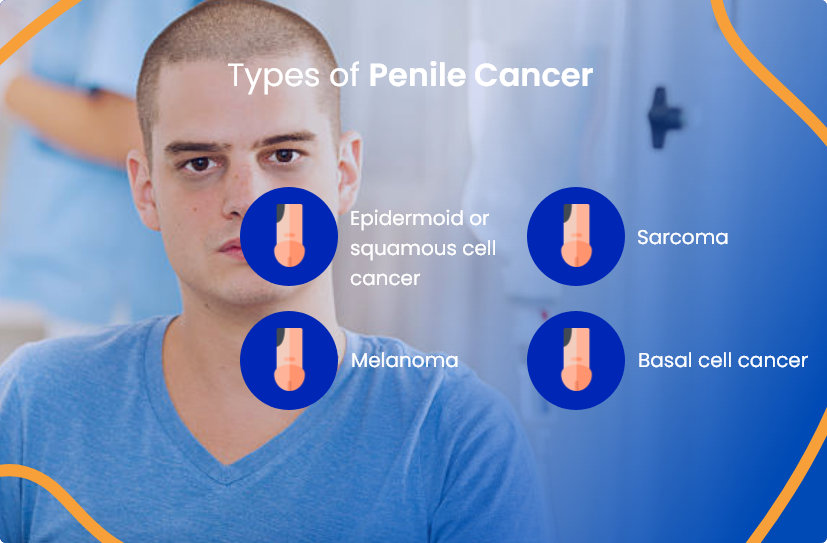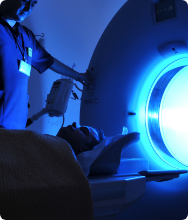
Book a Consultation
Thank you!
Your form has been sent successfully.

Often known as cancer of the penis, penile cancer is relatively uncommon, and it affects the tissues of the penis. It happens when the penis's typically healthy cells become cancerous and start to expand rapidly, eventually turning into a tumor.
Penile cancer is rare and accounts for only 0.4–0.6% of malignant diagnoses in the
USA and Europe. Eventually, this cancer may spread to the glands, other organs, and
lymph nodes, amongst other body parts.
The penis comprises a variety of cell types, one for each tissue type. These cells can serve as the origin of several types of penile cancer. The variations are significant since they establish the cancer's severity and the kind of treatment required. Nearly every type of penile cancer begins in the penis' skin cells.
Here are the four most common types of penile cancer:

Squamous cell cancer accounts for 95% of all cases of penile cancer in the United States. Although it typically begins on or beneath the foreskin, it can also develop in other areas of the penis.
Sarcomas are a rare type of penile cancer. These malignancies originate in the penis' blood arteries, smooth muscle, or other connective tissue cells.
Melanoma is a form of skin cancer that develops in melanocytes, the cells that give skin its brownish color and function as a sunblock. The majority of melanomas are located on sun-exposed skin, although they are a rare occurrence in the penis.
Another type of skin cancer that can appear on the penis is basal cell carcinoma, also called basal cell cancer. Only a small percentage of penile malignancies are caused by it. This kind of cancer grows slowly and seldom metastasizes to other body regions.
The signs of penile cancer are:
 skin thickness or color changes
skin thickness or color changes
 a penis rash or a couple of small crusty pimples
a penis rash or a couple of small crusty pimples
 bumps on the penile shaft
bumps on the penile shaft
 a foul discharge appears under the foreskin
a foul discharge appears under the foreskin
 an open sore on the penis that could bleed
an open sore on the penis that could bleed
 swelling at the penis's end
swelling at the penis's end
 lumps in the groin
lumps in the groin
Invasive and noninvasive penile cancer are the two primary subtypes. When penile cancer is noninvasive, it means that the disease has not penetrated deeper tissues, lymph nodes, or glands. Whereas invasive penile cancer spreads across the surrounding lymph nodes and glands as well as deeper layers of penis tissue.

Doctors conduct physical exams and ask about symptoms. A doctor might recommend more tests, such as:

Doctors take samples of tissue from lesions on the penis. Further, lab tests are conducted to detect cancerous cells.

X-rays, CT scans, ultrasounds, and magnetic resonance imaging (MRI) are examples of imaging procedures. The purpose of this test is to detect tumors or other indicators of cancer spread within the body.
Our patients have access to a multispecialty team of professionals at ACTC, who work together in a highly collaborative and coordinated manner to provide all aspects of cancer care in one convenient location in Brooksville, Florida. Our doctors are supported by a clinical team with over two decades of experience and a reputation for providing tailored and supportive cancer care.
The following are our providers who you can consult at ACTC:

MD, Hematology & Oncology

MD, Ph.D., Hematology/ Medical Oncology

MD, Radiation Oncologist

Cancer diagnosis is life-changing. It is therefore vital to have a cancer treatment center that walks with you through the whole treatment cycle. ACTC provides world-class care through its state-of-the-art technology and experienced cancer specialists. At every stage of the treatment process, from staging to long-term follow-up, we ensure that our patients feel supported every step of the way.
Schedule a consultation by calling
 352-345-4565
352-345-4565
Certain strains of a virus known as human papillomavirus are responsible for more than 50% of all cases of penile cancer (HPV) in the USA. There are different strains of HPV, and some impact the genital area.
The majority of cases of penile cancer occur in adults over 50. The typical age of diagnosis for penile cancer in the United States is roughly 68 years.
The cancer can appear anywhere, but the foreskin or the head of the penis (glans) is the most typical location (in uncircumcised men). Usually, this type of growth takes place over a long period of time, but on rare occasions, it may occur more quickly.
Schedule a consultation by calling
 352-345-4565
352-345-4565